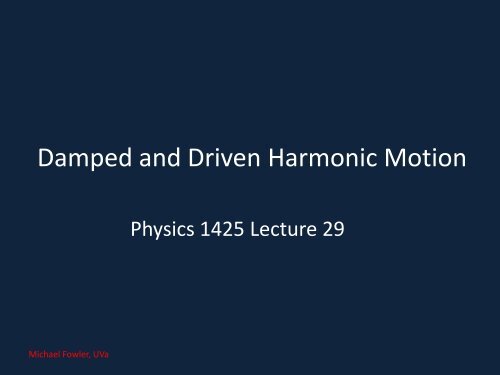29. Damped Driven Oscillators - Galileo and Einstein
29. Damped Driven Oscillators - Galileo and Einstein
29. Damped Driven Oscillators - Galileo and Einstein
Create successful ePaper yourself
Turn your PDF publications into a flip-book with our unique Google optimized e-Paper software.
<strong>Damped</strong> <strong>and</strong> <strong>Driven</strong> Harmonic Motion<br />
Michael Fowler, UVa<br />
Physics 1425 Lecture 29
<strong>Damped</strong> Harmonic Motion<br />
• In the real world, oscillators<br />
experience damping forces:<br />
friction, air resistance, etc.<br />
• These forces always oppose<br />
the motion: as an example,<br />
we consider a force F = −bv<br />
proportional to velocity.<br />
• Then F = ma becomes:<br />
ma = −kx −bv<br />
2 2<br />
• That is,<br />
• C<br />
md x / dt + bdx / dt + kx = 0<br />
Spring’s force<br />
F = −kx F = −bv<br />
Extension x<br />
Drag force<br />
m<br />
The direction of drag force<br />
shown is on the assumption that<br />
the mass is moving to the left.
Underdamped Motion<br />
• The equation of motion<br />
2 2<br />
md x / dt + bdx / dt + kx = 0<br />
has solution<br />
− γ t<br />
x = Ae cosω′<br />
t<br />
where<br />
γ = b/2 m,<br />
( ) ( 2 2<br />
k / m b /4m<br />
)<br />
ω′<br />
= −<br />
Plot: m = 1, k = 4, b = 0.11
Underdamped Motion<br />
• The point to note here is<br />
that the damping can<br />
cause rapid decay of the<br />
oscillations without a<br />
perceptible change in<br />
the period (around<br />
0.04% for b = 0.11, k = 4,<br />
m = 1).
Underdamped Motion<br />
• Compare the curve with<br />
the equation: the<br />
successive position<br />
maxima follow an<br />
t<br />
Ae γ −<br />
exponential curve ,<br />
so any maximum reached<br />
is, say, 90% of the<br />
previous maximum.<br />
• Remember the energy at<br />
maximum displacement<br />
is ½kx2 .<br />
• a<br />
− γ t ′<br />
x = Ae cosω<br />
t
Clicker Question<br />
• The amplitude in a damped oscillator reaches<br />
half its original value after four cycles. At<br />
which point does the oscillator have only half<br />
its original energy?<br />
A. 2 cycles<br />
B. 4 cycles<br />
C. 8 cycles
Not So Underdamped Motion<br />
Even when the<br />
damping absorbs<br />
98% of the energy<br />
in one period, the<br />
change in the<br />
length of the<br />
period is only<br />
around 10%!<br />
• a
• As the damping is<br />
further increased, the<br />
period lengthens until<br />
at b 2 = 4mk it becomes<br />
infinite, <strong>and</strong> the<br />
amplitude decays<br />
exponentially.<br />
• (Actually, in this one case a<br />
prefactor A + Bt is needed to<br />
match initial conditions—we’ll<br />
ignore this minor refinement.)<br />
Critical Damping
• Doubling the<br />
damping beyond<br />
critical damping just<br />
doubles the time for<br />
the amplitude to<br />
decay by a given<br />
amount.<br />
Overdamping
Ideal Damping for Shock Absorbers?<br />
• Critical damping is<br />
not the best choice:<br />
underdamping gives<br />
a quicker response,<br />
<strong>and</strong> the overshoot<br />
can be very small.<br />
• Explore this for<br />
yourself: download<br />
the spreadsheet!
The <strong>Damped</strong> <strong>Driven</strong> Oscillator<br />
• We now consider a damped oscillator with an<br />
external harmonic driving force.<br />
• We’ll look at the case where the oscillator is<br />
well underdamped, <strong>and</strong> so will oscillate<br />
naturally at ω .<br />
0 = k / m<br />
• The external driving force is in general at a<br />
different frequency, the equation of motion is:<br />
2 2<br />
md x / dt + bdx / dt + kx =<br />
F cosωt<br />
0
The <strong>Damped</strong> <strong>Driven</strong> Oscillator<br />
• If the driving frequency is far<br />
from the natural frequency,<br />
there is only a small<br />
response, even with no<br />
damping. Here the driving<br />
frequency is about twice the<br />
natural frequency.
The <strong>Damped</strong> <strong>Driven</strong> Oscillator<br />
• This shows the<br />
oscillator with the same<br />
strength of external<br />
driving force, but at its<br />
natural frequency.<br />
• The amplitude<br />
increases until damping<br />
energy losses equal<br />
external power input:<br />
this is resonance.<br />
• Spreadsheet link!<br />
• Tacoma Narrows Bridge.


